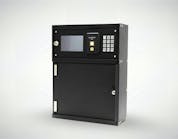Frank Best created the small format interchangeable core (SFIC) as a convenient and inexpensive lock mechanism that can be removed and installed in seconds by non-locksmith personnel with no knowledge of lock mechanisms. The original Lock Patent 1,384,022 was filed on August 28, 1919. The Interchangeable Lock Core patent was granted September 21, 1965. The Interchangeable Lock Core’s patent appears very similar to Best/Falcon (SFIC) interchangeable cores that have been manufactured over the last 50 years.
The basis of the interchangeable core system is the dual locking mechanism built into the interchangeable lock core. The core performs a double duty, operating the locking mechanism and having a secondary shearline that permits it to be removable. To operate, the core must be in a housing, which could be a mortise or rim cylinder, lever, padlock, etc.
The core is held in place by a lug that is part of the secondary shearline of the sleeve. The control (second) shearline is operated by the control key that rotates 15 degrees clockwise in order to retract the lug into the housing. In this position, the interchangeable lock core can be removed and inserted. Once the core has been removed, the combination can be changed or a different core inserted. The control key is designed only to remove the core, not to operate the lock.
The SFIC uses top, control, master and bottom pins that are .108” diameter; they are seven thousandths of an inch smaller in diameter than the conventional lock cylinder, which uses the .115” diameter pins.
Since the introduction of the Best/Falcon interchangeable core, Best developed the A2, A3 and A4 systems to provide expanded keying options. The A2 system is based on a .0125” increment between pin lengths. The A3 system is based on a .018” increment. The A4 system is based on a .021” increment.
IC cores are manufactured by a number of companies, including Arrow, Best Access, Corbin-Russwin, CX-5, DORMA, Falcon Lock, GMS, Ilco, KSP, Medeco, PDQ, Sargent Lock, Schlage Lock, Ultra Security and Yale Lock.
Some manufacturers offer higher security and patented key control. Specialized SFIC cores are manufactured to the basic outside dimensions allowing interoperability between manufacturers of interchangeable core lock housing products. For example, Medeco has KeyMark Interchangeable Core, CX-5 has the Waved Security Groove, Kaba Ilco has the Peaks and Schlage has the Everest.
Most interchangeable core keys are tip stop keys. However, a few companies have made changes and are using shoulder stop keys. For example, Schlage SFICs use shoulder stop keys.
There are three distinct types and bottom pin shapes for SFICs. Two are brass bottom pins and one is nickel silver bottom pins. Best style brass bottom pins are designed for Best cores as they are manufactured of brass and operated by brass keys. The second style of brass bottom pins is the color coded (aftermarket) pins designed to be used in cores operated by brass keys. Nickel silver bottom pins are designed to be used in cores operated with nickel silver key blanks. These include Falcon, Schlage SFIC, Medeco Keymark, etc.
Each pin style offers specific functionality. Lock manufacturers strongly recommend using bottom pins that are manufactured of the same material as the original equipment keys and where possible cores. Brass bottom pins should be operated with brass keys and nickel silver bottom pins should be operated with nickel silver bottom pins. Similar materials will have even wear on the bottom pins and keys. Over time, dissimilar materials will have uneven wear on the softer metals' surface. This uneven wear can result in core failure.
Interchangeable Core keys are cut to very tight tolerances. The increment is only .0125”, along with smaller diameter pins and cores constructed to tighter tolerances. For this reason, it is always recommended that interchangeable core keys be originated, not duplicated.
Duplicating and even originating different interchangeable core key blade profiles using rotary key machines can be difficult to align. These mostly paracentric designed blades have many different blade profiles. In addition, some of the sectional applications can be very thin. This can result in difficulty securing the key blade within the key vise.
What can and does often happen when the non-conforming key blank blade is secured in generic vise jaw is the key blade becomes distorted as the vise jaw is tightened. The distortion usually causes one or more of the cuts to be either too shallow or too deep and to some amount out of position. When the cut key is removed from the vise jaw, the blade will straighten out somewhat. However the distortion changes the cut geometry and the shape of the blade, which can weaken it and result in breaking over time.
For this reason, using a dedicated keypunch machine can be the answer to originating the more difficult IC keys. The keypunch machine vise jaw is usually designed for interchangeable core key blades. In addition, the cutter is specifically designed for the origination procedure, having the correct flat and fixed depths and spacing. Standard spacing for SFIC is .150” cut-to-cut.
In most instances, purchasing a keypunch machine should occur after the interchangeable core system has been selected. This enables purchasing the correct key originating equipment, having the proper space and depths and the proper vise jaws.
IC key punch machines include the A1 Security Manufacturing PAK-1C, the A1 Security Manufacturing Mean Green Machine, the Best Combinator, the Pro-Lok Blue Punch and the Rytan RY2000. The A1 Security PAK-1C is a handheld keypunch machine. Note: Before purchasing a keypunch machine or any key machine dedicated for interchangeable core, test your key blank.
Interchangeable Core key blanks are available from lock manufacturers, core producers and aftermarket key blank manufacturers. More than 30 known keyways are manufactured for Best key systems. In addition, other manufacturers offer their own keyways. Depending upon the aftermarket key blank manufacturer, key blanks can be available in different configurations including the standard head and neuter bow. “Do Not Duplicate” key blanks are also available. Note: The “Do Not duplicate” key blank marking is not legally binding in many parts of the world.
Servicing Tools
Servicing Best/Falcon interchangeable cores have become easier over the years with the development of new products. These include key gauges, pinning slide charts and QU-I.C-KEY, loading/capping blocks, dumping/decoding blocks, loader/decoders, I-core tension tools, drill jigs and capping presses.
Key gauges are stamped metal plates with one or more tapering slots used to determine the depths of cuts in keys. To decode, insert a key blade into the larger end of the slot with the bottom of the blade above the numbers. Stop when the cut to be decoded is centrally aligned with the metal plate. Slide the key towards the smaller end, until the portion of the blade remaining cannot slide further. Read the depth of cut stamped into the tool. Interchangeable core key gauges are available in different configurations. Some have only a single slot, while others have three slots for the A2, A3 and A4 Systems.
To determine the pinning for A2 System Interchangeable Cores, LAB developed a slide chart, the LAB LSC001 - EASY WAY I.Core Pinning Slide Chart, that displays pin stacks for one pin chamber at a time.
For larger interchangeable core jobs, the Ultra Security QU-I.C-Key System provides customized and fast master keying information for a single or multiple six- or seven-pin SFIC keying systems. The QU-I.C-KEY pin segment calculator provides every pin segment calculation for a system using a color -coded system. The QU-I.C.LOAD tool holds the core and provides color-coded chamber identifiers that match the calculator for rapid pin tumbler loading. The QTT Test Tool allows the core to be tested prior to installing the spring retainer.
A number of manufacturers offer loading blocks and dumping blocks to simplify combinating and emptying the core's pin tumblers. A dumping block is used to remove the cap, spring and pin tumblers from each chamber in the core. Dumping blocks can be used to unload one or more pin chambers at a time. Dumping blocks require an ejector pin to release the cap.
Some dumping blocks have a built-in decoding mechanism. Using a decoding dumping block, when each pin stack is pushed out of the core, the components slide into a dedicated chamber. After the desired pin stacks have been dumped, laying the dumping/decoding block on its side and opening it has each chambers pins in their order of being loaded. This enables all of the pin lengths to be decoded, in order to determine the operating, master and/or the control keys depths of cuts for each chamber. Decoding blocks require an ejector pin to release the cap. Most dumping/decoding tools come with an ejector pin.
Loading blocks provide a holding fixture to load the pins and springs. Loading/capping blocks are used to load the pins and springs and are used to set the cap, keeping each Best style core pin chamber properly sealed. There are a number of different loading and loading/capping blocks. Loading blocks require a capping tool to set the caps. Remember: Some Falcon cores use a spring cover in place of the individual pin chamber caps.
The stainless steel LAB Interchangeable Core Annex, part number LICCB, is a loading/capping, dumping and decoder in one block. The Core Annex allows the user to dump the core pins, springs, and caps from each chamber into a confined area. Once dumped, the code book can be slid out of the block. Inside, the pins are in order separated by slots. The pins can be decoded and the control key depths of cut can be determined. The Core Annex comes with a capping tool to set the caps and an ejector tool to release the caps.
Dedicated capping presses simplify capping Best/Falcon style interchangeable cores. The capping press controls the distance the cap can enter the core, limiting the ability to deform the cap. Capping presses are available with single chamber capping or six chambers at the same time. A1 Security Manufacturing’s Capsaver Press, part number CAP-5, creates its own caps from a brass strip and seats them. This eliminates the need to place one cap over each chamber opening.
The next tool makes life easier if the control key depths of cut are unknown. IC core tension (turning) tools eliminate the problem that can and usually does occur when picking for the control shearline using a standard tension tool. When using a regular tension (turning) tool, you have a 50-50 chance of picking the core at the control shearline, dependent upon luck. Specially designed interchangeable core tension tools pick only the control shearline. For example, the Peterson's I-Core Tension Tools have a profiled foot that firmly grasps the holes in the control sleeve. The I-Core Tension Tools operate on Best/Falcon style of interchangeable cores with access holes drilled through the housing and the control sleeve.
When a core is damaged and the control key will not retract the lug, the question becomes whether to drill the core or the housing to remove the core from the door hardware. This destructive decision is determined by knowing the condition of the core. If the core is malfunctioning and cannot be repaired, drill the core. If the housing is expensive, drill the core. If the core is not easily replaced or you do not have one on the jobsite and you think you can repair the core, consider drilling the housing if you have replacement housings.
The same is true if the control depths of cut are not known and you are unable to pick the control shearline. If you are drilling out the core, do not damage the top pins. Insert a key blank into the keyway to raise the pins to avoid damaging the top pins when drilling the control shearline. Remember: Drilling a core is a one-time operation.
Drill jigs available for drilling interchangeable cores. Should you decide to drill, make sure the jig uses drills at the location and size of hole you want. The Peterson Manufacturing I-Core Drill jig for SFIC cores is designed to allow the core to be decoded without damaging the door hardware once it has been drilled and removed. The tool comes with complete instructions, drill bits and guides.
Tools for servicing interchangeable cores makes life a whole lot easier.
FMI
For more information on interchangeable cores and tools, contact your local locksmith distributor or the following manufacturers:
- A1 Security Manufacturing: http://demanda1.com
- Arrow Lock: www.arrowlock.com
- Best: www.bestaccess.com
- Cal-Royal Products: www.cal-royal.com
- Corbin Russwin: www.corbinrusswin.com
- CX5 Security Solutions: www.cx5security.com
- DORMA: www.dorma.com/us/en
- Falcon: http://us.allegion.com/brands/falcon/Pages/default.aspx
- GMS Lock Cylinders: www.gmslock.com
- Hager: www.hagerco.com
- Kaba Ilco: www.kaba-ilco.com
- KSP: www.iccore.com
- LAB: www.labpins.com
- Medeco: www.medeco.com
- PDQ: www.pdqlocks.com
- Peterson Locksmith Tools: www.thinkpeterson.com
- Pro-Lok: www.prolok.com
- Rytan: www.rytan.com
- Sargent: www.sargentlock.com
- Schlage: www.schlage.com
- Ultra Security: http://ultrasecurityusa.com/
- Yale: www.yalecommercial.com





